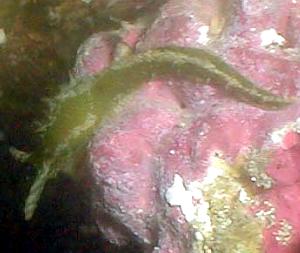This guy suddenly appeared in my aquarium!
October 7, 2000
From: Matt Galvin


Hi everyone!
Am hoping somebody can help me identify this guy. I was watching my aquarium one day and noticed him moving around on the glass. He's about an inch long, and I've since seen him on the glass and rockwork. I've also seen several smaller ones (< 1 cm) since then.
If someone knows what he is, can you also let me know anything special about him? Such as what does he eat, what his survival chance is, etc?
Hopefully someone can help!
tia!...
Matt
luminary@liquidchaos.net
Galvin, M., 2000 (Oct 7) This guy suddenly appeared in my aquarium!. [Message in] Sea Slug Forum. Australian Museum, Sydney. Available from http://www.seaslugforum.net/find/3120Dear Matt,
This is a sacoglossan sea slug of the genus Oxynoe. I am pretty sure it is Oxynoe antillarum Morch 1863 which is found in the tropical and subtropical western Atlantic from Florida to northern Brazil. It feeds on the bright green sea weed Caulerpa. I have no idea where you live or where your aquarium animals came from but if you have added rocks or green weed from the Caribbean recently, that is the most likely place your Oxynoe came from.
What can I tell you about them. Firstly you should stop calling them 'he', because like all sea slugs they are hermaphrodites with a full set of male and female organs. They are sacoglossan sea slugs, not nudibranchs. Have a look at the animals in the Species List under the ORDER SACOGLOSSA. If you look at some of these you will see they range from snail-like animals with an external shell to bright colourful slugs. They are all herbivores, and they all feed by piercing the cell walls of the sea weeds, with a sharp dagger-like tooth, and sucking out the cell sap.
Your Oxynoe has a fragile colourless shell which is no longer strong enough to protect it from predators. If you irritate this animal, or for that matter most sacoglossans, they will exude a thick milky white secretion from their skin. This contains unpleasant chemicals, some of which are thought to be derived from the plants they feed on. This secretion deters predators.
If you keep some Caulerpa in your aquarium, your slugs will probably live quite happily for some months.
Best wishes,
Bill Rudman.
Related messages
-
Mating Oxynoe antillarum
From: Lureen Ferretti, September 1, 2009 -
Oxynoe antillarum from Jamaica
From: Ross W. Gundersen, October 14, 2003 -
Oxynoe antillarum from Belize
From: Dave Behrens, October 19, 2002 -
Unknown stowaway on Caulerpa
From: James Stein, September 3, 2002 -
Lime green sea slug
From: Don Pelino, April 16, 2002
